Key Points
Japanese Zen gardens are a representation of tranquility and balance. Each plant in these gardens has a specific aesthetic and symbolic role.
Coniferous trees such as the Japanese Black Pine are essential for maintaining structure and form throughout the year.
Evergreen shrubs like Azaleas and Camellias provide lush foliage and bright flowers.
Deciduous trees such as the Japanese Maples add seasonal color and texture changes to the garden.
Ground covers, mosses, and ferns complete the Zen garden look by covering the understory with a calming carpet.
Overview
Essentially, a Japanese garden isn’t merely a compilation of plants. It’s a carefully constructed landscape that conveys a tale of tranquility and minimalism. The plants chosen aren’t just foliage; they’re the strokes of a living artwork, chosen for their capacity to cultivate a reflective environment.
Who Is This Guide For?
If you’re an experienced gardener seeking to incorporate Zen elements into your green space or a newbie enchanted by the serenity of Japanese gardens, this guide will give you the information and motivation you need to craft your own tranquil haven. We have curated a selection of trees, shrubs, flowers, bamboo, moss and ground covers, carefully selected for their unique characteristics, suitability for different garden sizes, and ease of care.
Disclaimer: The plant list and variety descriptions included in this article are based on recommendations from Yoko Kawaguchi as found in ‘Authentic Japanese Gardens’ book. This article serves as a reference guide and does not intend to infringe upon the intellectual property rights of the author or publisher.
I. Plants to Use in Japanese Gardens
1) Coniferous Trees: A Selection of Pine, Juniper, Cedar, Cypress, and Exotic Varieties

“Japanese White Pine” from atlantabg.org and used with no modifications.
Coniferous trees in Zen gardens often stand for longevity and immortality. Their evergreen character and hardy shapes make them perfect for giving form and a feeling of permanence. Their year-round leaves also provide a sharp contrast to the changing seasons represented by deciduous trees. The Japanese Red Pine, with its red-brown bark and long needles, adds a touch of elegance and resilience, while the Hollywood Juniper, known for its unique, irregular shape and twisted branches, introduces a dynamic and artistic element to the garden landscape.
Pine Varieties
|
Scientific Name |
Common Name |
USDA Hardiness Zones |
Features |
Size and Dimension in Feet |
|---|---|---|---|---|
|
Pinus densiflora |
Japanese Red Pine |
Zones 5-9 |
Native to Japan, red-brown bark, long needles in clusters of two |
20-40 feet tall by 20-35 feet wide |
|
Pinus parviflora |
Japanese White Pine |
Zones 5-8 |
Elegant, slow-growing tree with blue-green needles in bundles of five |
20-50 feet tall by 15-25 feet wide |
|
Pinus thunbergii |
Japanese Black Pine |
Zones 5-9 |
Coastal native, dark green needles, rugged appearance |
20-60 feet tall by 15-35 feet wide |
Juniper Varieties
|
Scientific Name |
Common Name |
USDA Hardiness Zones |
Features |
Size and Dimension in Feet |
|---|---|---|---|---|
|
Juniperus chinensis |
Hollywood Juniper |
Zones 4-9 |
Unique, irregularly shaped juniper with twisted branches and blue-green foliage |
6-15 feet tall by 3-5 feet wide |
|
Juniperus conferta |
Shore Juniper |
Zones 6-9 |
Dense evergreen shrub found along sand dunes and rocky seashores in Japan |
1-2 feet tall by 6-8 feet wide |
Cedar and Cypress Varieties
|
Scientific Name |
Common Name |
USDA Hardiness Zones |
Features |
Size and Dimension in Feet |
|---|---|---|---|---|
|
Chamaecyparis obtusa var. breviramea |
Chabo-hiba/Kamakura-hiba |
Zones 4-8 |
Dwarf form of Japanese hinoki cypress, compact and slow-growing |
3 feet tall by 2 feet wide |
|
Chamaecyparis pisifera ‘Plumosa’ |
Nikko-hiba/Shinobu-hiba |
Zones 4-8 |
Dwarf garden cultivar of Japanese sawara cypress, tolerant of hard pruning, used for topiary and hedges |
6-10 feet tall by 4-6 feet wide |
|
Cryptomeria japonica |
Sugi |
Zones 5-9 |
Tall, conical evergreen tree with reddish-brown bark and scale-like leaves |
50-70 feet tall by 20-30 feet wide |
Exotic Conifers
|
Scientific Name |
Common Name |
USDA Hardiness Zones |
Features |
Size and Dimension in Feet |
|---|---|---|---|---|
|
Podocarpus macrophyllus |
Kusa-maki |
Zones 7-10 |
Dense evergreen with dark green foliage and red fruits |
20-40 feet tall by 10-20 feet wide |
|
Sciadopitys verticillata |
Umbrella Pine |
Zones 5-7 |
Unique umbrella-like appearance, dark green needles in whorls |
30-50 feet tall by 15-25 feet wide |
|
Taxus cuspidata |
Japanese Yew |
Zones 4b-7a |
Dark green foliage, red berries, tolerant of shade and pruning |
10-20 feet tall by the same width |
|
Thujopsis dolobrata |
Hiba-arborvitae |
Zones 5b-7a |
Conical shape, aromatic foliage, reddish-brown bark |
30-50 feet tall by the same width |
|
Torreya Nucifera |
Japanese Nutmeg Yew |
Zones 6-9 |
Slow-growing evergreen tree with dark green needles and fleshy red fruits |
30-40 feet tall by 15-25 feet wide |
For a more comprehensive list of Japanese garden conifers, check out here.
2) Evergreen Trees in Zen Gardens
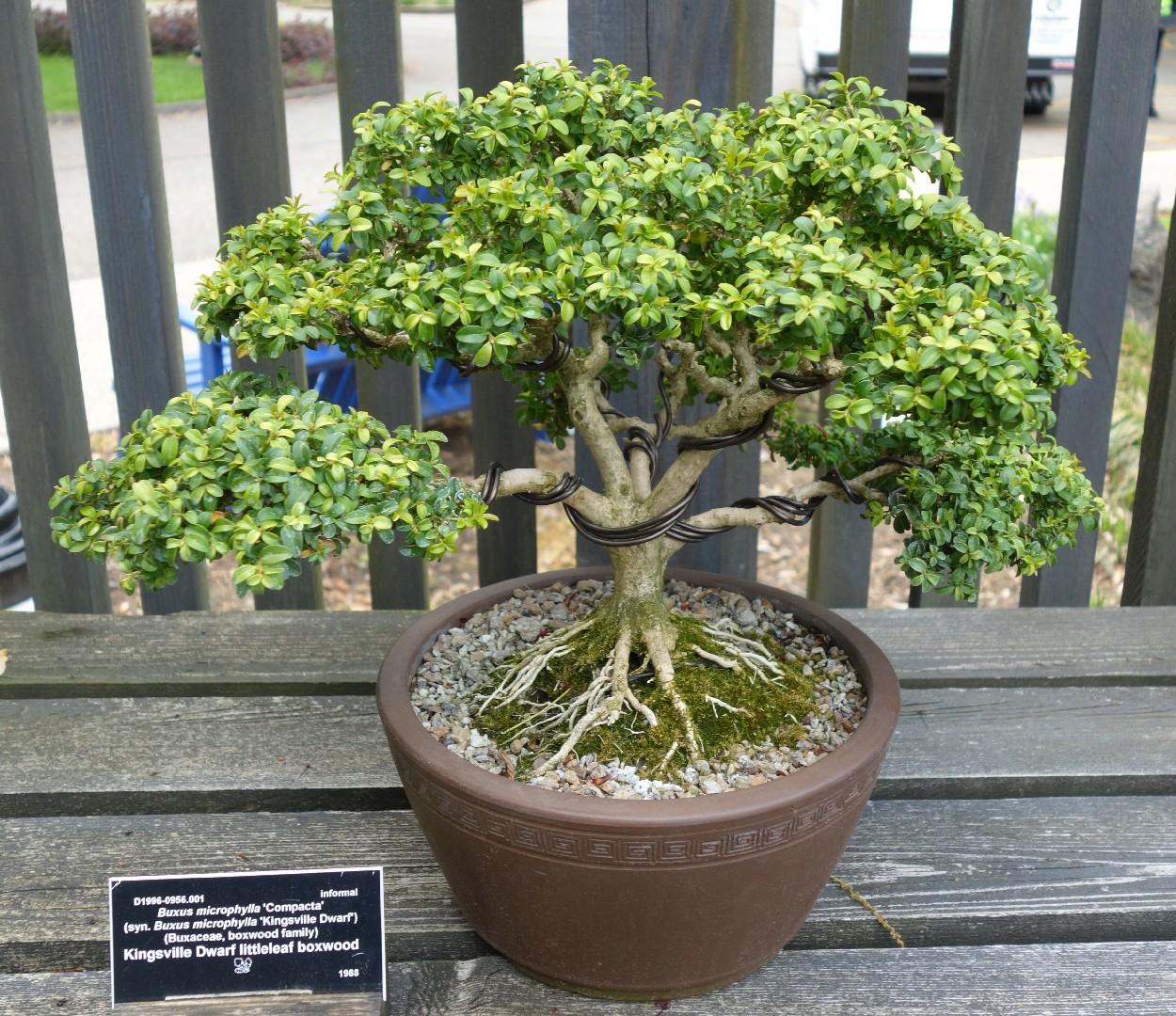
“Japanese box (Buxus microphylla) Flower …” from www.picturethisai.com and used with no modifications.
Apart from conifers, other evergreens can bring diversity and texture to your garden. They keep their leaves all year round, offering a steady backdrop of vitality against the more transient parts of the garden.
In this verdant ensemble, the Buxus microphylla var. japonica (Japanese box; tsuge) and Cleyera japonica (sakaki) are two evergreens that enrich the garden’s palette. The Japanese box, with its potential for hedges and topiaries, and the sakaki, a broadleaf evergreen sacred in Shinto religion, both symbolize the ongoing present moment, a core principle in Zen philosophy.
|
Scientific & Common Name |
USDA Hardiness Zone |
Description |
Size |
Care Tips |
|---|---|---|---|---|
|
Buxus microphylla var. japonica (Japanese box; tsuge) |
6 through 9 |
Evergreen shrub native to Japan, used for hedges and topiaries, wood used for making combs |
Up to 5 m (16 ft 3 in) |
Very slow growth; care needed in transplanting; prefers half-shade; likes lime; mulch to prevent shallow roots from drying out |
|
Cleyera japonica (sakaki) |
7 through 8, warmer areas of 6 |
Broadleaf evergreen shrub or small tree, sacred in Shinto religion, used around shrines and in tea gardens |
3 x 3 m (10 x 10 ft) |
Prefers rich, deep, acid soil and shade; can be pruned hard for broad hedges; suitable as underplanting |
|
Daphniphyllum macropodum (yuzuriha) |
7 through 9 |
Evergreen tree with leaves in whorls, used for New Year’s decorations, suitable for mass planting |
Up to 15 m (49 ft) |
Frost hardy; prefers rich soil and half-shade; no pruning needed; dislikes root disturbance |
|
Dendropanax trifidus (kakure-mino) |
7 through 9 |
Evergreen tree used around shrines and in tea gardens, very slow-growing |
10 m (32 ft 6 in) |
Frost hardy; prefers moist shade; dislikes being pruned and root disturbance; suitable for north-facing gardens |
|
Ilex crenata (box-leaved holly/Japanese holly; inu-tsuge) |
6 through 9 |
Small, round, glossy leaves, important for topiary in Japan, slow-growing but vigorous |
5 x 4 m (16 ft 3 in x 13 ft) |
Prefers partial shade and moist conditions; avoid winter wind; if soil is alkaline, give an annual feed of acid fertilizer |
|
Ilex integra (mochi-no-ki) |
8 through 9 |
Evergreen tree used near shrines, can be transplanted even when quite big |
7 to 8 m (23 to 26 ft) |
Young plants half hardy; established plants tolerate down to -10°C/14°F; prefers moist, rich soil and sun; prune heavily in early summer |
|
Ilex latifolia (luster-leaf holly; tarayo) |
7 through 9 |
Large, serrated leathery leaves with male and female plants for red berries production |
6 to 7.5m (20 to 25ft) |
Can be hard pruned or clipped for a dense screen; best pruned late winter-early spring; frost hardy |
|
Ilex pedunculosa (long-stalk holly; soyogo) |
5 |
Upright habit with both male and female plants needed for red autumn berries |
Up to 6m (20ft) |
Prefers moist, slightly acidic, well-drained soil; full sun to partial shade; tolerant of air pollution and some sea-air |
|
Ilex rotunda (kurogane holly/round-leaf holly; kurogane-mochi) |
6 through 9 |
Slow-growing evergreen, female plants produce red berries in winter, popular for bonsai |
9 to 15m (30 to 50ft) |
Prune lightly Nov-Dec, then hard late spring; tolerates partial shade |
|
Lithocarpus edulis (Japanese stone oak; mate-bashii) |
7 through 9 |
Fast-growing, suitable for hedging or mass planting |
10 m (32 ft 6 in) |
Hardy; sun or partial shade; tolerates heavy pruning |
|
Pittosporum tobira (Japanese mock orange; tobera) |
8 through 11 |
Dense evergreen with fragrant white flowers and red seeds in winter |
2 to 9m (6 to 30ft) |
Tolerant of sea air and some dryness; no pruning required; cultivars with variegated leaves available |
|
Osmanthus x fortunei (Fortune’s osmanthus; hiiragi-mokusei) |
7 through 9 |
Upright with holly-like leaves, fragrant white flowers in late summer to autumn |
5 m (16 ft 3 in) |
Frost hardy; half-shade or complete shade; prune; tolerates sea air; suitable for hedges |
|
Osmanthus heterophyllus (holly osmanthus; hiiragi) |
7 through 9 |
Dense round shrub with spiny, leathery leaves, fragrant white flowers on female plants |
4 to 8 m (13 to 26 ft) |
Frost hardy; tolerates shade and sea air; can be pruned; suitable for hedges |
|
Quercus glauca (ring-cup oak; ara-kashi) |
7 through 9 |
Slow-growing live oak with serrated lance-shaped leaves, good for hedges, windbreaks, screens |
Up to 9m (30ft) |
Frost hardy; leaves turn from purple-crimson to glossy green and glaucous blue-green underneath |
|
Quercus myrsinifolia (bamboo-leaf oak/Chinese evergreen oak/Chinese ring-cupped oak; shira-kashi) |
7 through 9 |
Slow-growing live oak with glossy lance-shaped leaves emerging bronze-red |
6 to 12m (20 to 40ft) |
Shade tolerant; prune for a dense hedge in July and November; traditionally used as windbreaks; plant shrubs 30cm apart for a 1m tall hedge, 50cm apart for a 1.5m tall hedge |
|
Quercus phillyraeoides (ubame-gashi) |
7 through 10 |
Slow-growing, dense live oak with glossy ovate leaves and fissured brown-grey bark |
6 to 9m (20-30ft) |
Suitable for hedges; prune late autumn; stop main leading stem at required height and cut back lateral branches to desired length; prefers acid to neutral soil |
|
Ternstroemia gymnanthera (mokkoku) |
7 through 10 |
Frost hardy to half hardy in the UK; dislikes temperatures below -5°C/23°F; ripe wood tolerates colder conditions |
5 to 10 m (16 to 32 ft 6 in) |
Partial or complete shade; prefers rich acid soil; in early summer remove the longest central stem from each new growth |
For more information on ‘Evergreen trees in Japanese Gardens’, explore our detailed guide here.
3) Evergreen Bushes & Shrubs
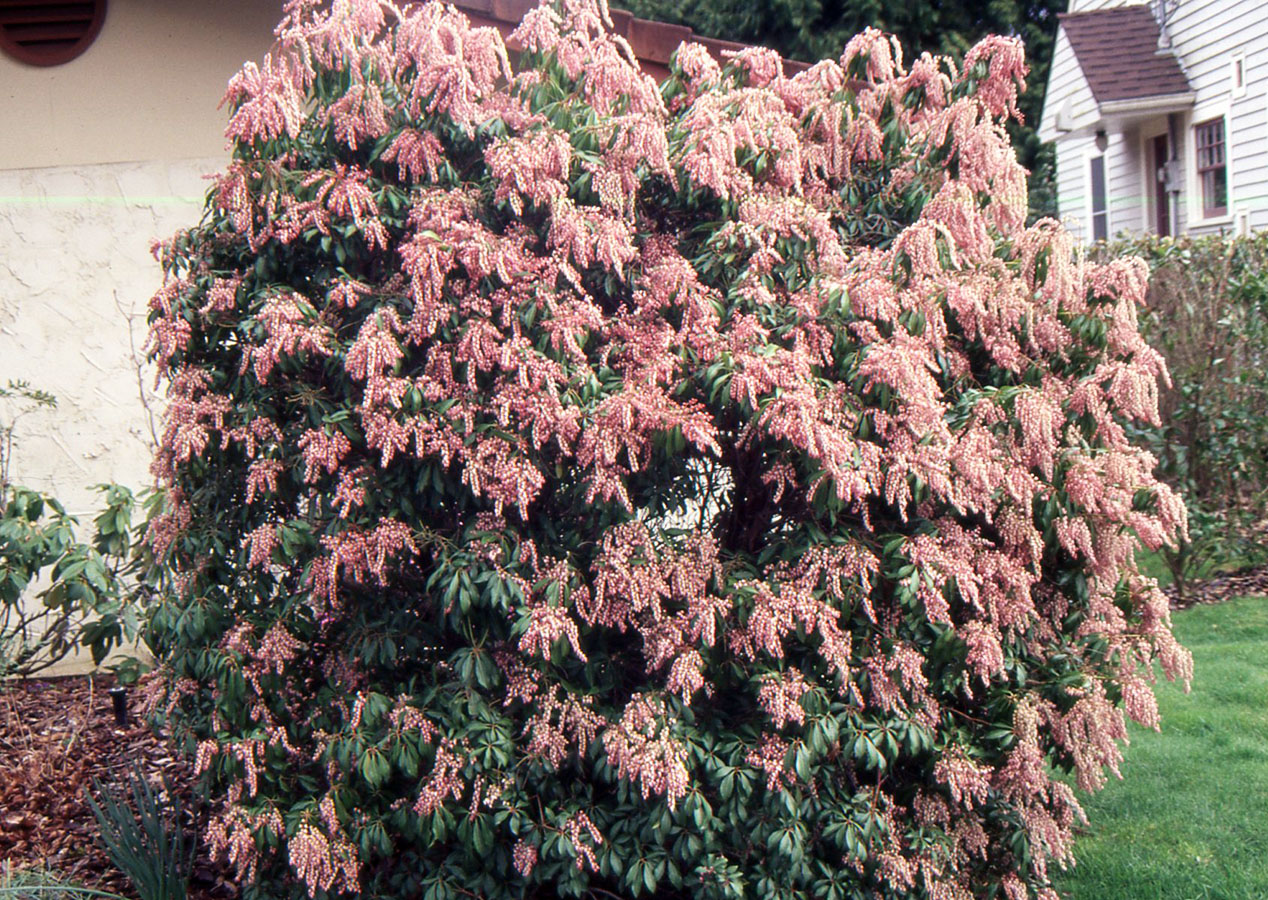
“Pieris japonica | Landscape Plants …” from landscapeplants.oregonstate.edu and used with no modifications.
Evergreen bushes require specific care to thrive, including pruning that accentuates their natural shape and soil that is well-draining and rich in organic matter. For a low-maintenance Zen garden, evergreen shrubs like Ardisia japonica (Marlberry, Yabu-koji) and Aucuba japonica (Spotted Laurel, Aoki) are excellent choices. Marlberry delights with its pink flower clusters and red berries, while Spotted Laurel stands out with its variegated leaves and tolerance for shade and dry conditions.
If you’re looking for a Zen garden that doesn’t require much maintenance, evergreen shrubs are a smart option. They need less pruning than plants that lose their leaves, and they keep their leaves all year, which means less garden waste.
|
Scientific Name |
Common Name |
USDA Hardiness Zones |
Features |
Size and Dimension in Feet |
|---|---|---|---|---|
|
Ardisia japonica |
Marlberry, Yabu-koji |
Zones 7a – 11 |
Evergreen shrub with clusters of pink flowers and red berries |
Height: 0.5 to 1 foot, Spread: 6 inches to 3 feet |
|
Aucuba japonica |
Spotted Laurel, Aoki |
Zones 7a, 7b, 8a, 8b, 9a, 9b |
Evergreen shrub with variegated leaves, tolerates shade, dry soil, pollution |
Height: 6 to 10 feet, Spread: 5 to 9 feet |
|
Camellia sinensis |
Tea, Cha-no-ki |
Zones 7 to 9 |
Evergreen shrub/small tree, white flowers, leaves used for tea |
Height: 6 to 15 feet (can grow taller) |
|
Elaeagnus x ebbingei |
Ebbing’s Silverberry |
Zones 7 to 11 |
Dense evergreen, silver/gold variegated leaves, fragrant flowers |
Height: 8 to 10 feet, Spread: 8 to 10 feet |
|
Euonymus japonicus |
Japanese Spindle, Masaki |
Zones 6 to 9 |
Glossy green leaves, often used for hedges, variegated foliage |
Height: 6 to 15 feet, Spread: 2 to 8 feet |
|
Eurya japonica |
Hi-sakaki |
Zones 7 to 9 |
Small evergreen shrub, dense foliage, small flowers |
Height: 2 to 5 feet, Spread: 2 to 5 feet |
|
Fatsia japonica |
Yatsude |
Zones 7 to 10 |
Large, palmate leaves, spherical white flowers |
Height: 6 to 10 feet, Spread: 6 to 10 feet |
|
Juniperus chinensis var. procumbens |
Hai-byakushin |
Zones 4 to 9 |
Low-growing juniper, spreading habit, used as ground cover |
Height: 1 to 2 feet, Spread: 4 to 6 feet |
|
Mahonia japonica |
Hiiragi-nanten |
Zones 7 to 9 |
Evergreen, holly-like leaves, yellow flowers |
Height: 4 to 6 feet, Spread: 4 to 6 feet |
|
Photinia glabra |
Red-leaf Photinia |
Zones 7 to 9 |
Bright red new foliage, matures to green |
Height: 10 to 15 feet, Spread: 10 to 15 feet |
|
Pieris japonica |
Japanese Andromeda |
Zones 5 to 8 |
Evergreen shrub, bell-shaped flowers, attractive foliage |
Height: 9 to 12 feet, Spread: 6 to 8 feet |
|
Viburnum odoratissimum |
Sweet Viburnum; Sangoju |
Zones 8 to 10 |
Dense evergreen, large glossy leaves, fragrant white flowers |
Height: 12 to 20 feet, Spread: 12 to 20 feet |
|
Viburnum suspensum |
Sandanqua Viburnum |
Zones 8 to 10 |
Evergreen shrub, leathery leaves, fragrant white flower. |
Typically 6 to 12 feet tall and wide. |
For more detailed guidance on ‘Evergreen Bushes & Shrubs on Japanese Gardens’ , consider exploring our detailed guide here.
4) Leafy & Deciduous Trees: Japanese Maples
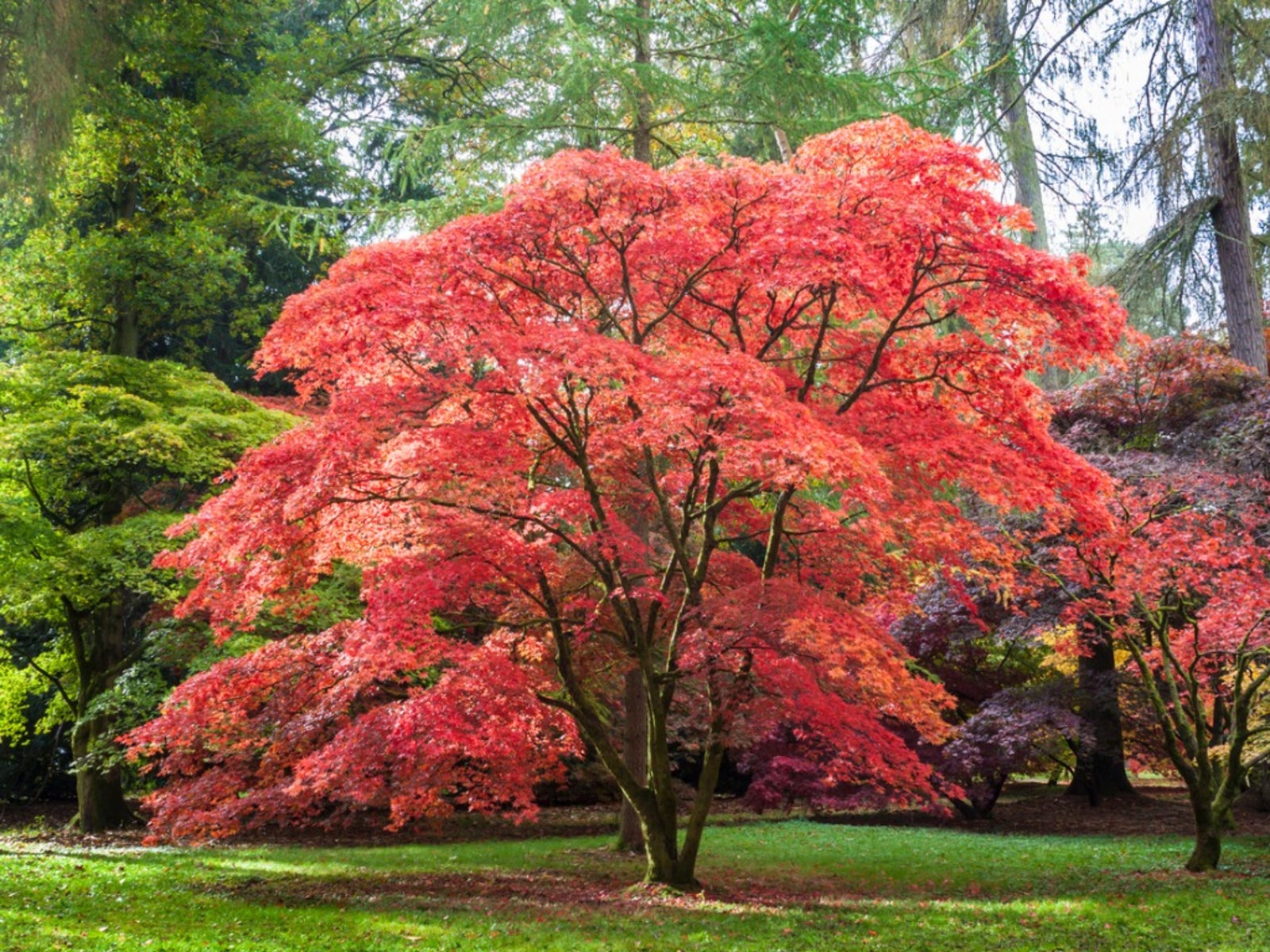
“Planting A Japanese Maple Tree: Tips On …” from www.gardeningknowhow.com and used with no modifications.
Japanese Maple trees are the stars of the Japanese garden, putting on a different show with each season. In the spring, their leaves gently unfold; in the summer, they provide a cool, shady retreat; in the fall, they burst into a riot of color; and in the winter, their naked branches create a beautiful silhouette against the sky.
Among them, Acer palmatum (Iroha-momiji) and Acer japonicum (Full Moon Maple) are quintessential examples. The Iroha-momiji, with its diverse leaf shapes and colors, offers stunning fall coloration, while the Full Moon Maple is celebrated for its large, round leaves that turn from gold to crimson in the fall, providing a breathtaking visual spectacle.
|
Scientific Name |
Common Name |
USDA Hardiness Zones |
Features |
Size and Dimensions (feet) |
|---|---|---|---|---|
|
Acer buergerianum |
Trident Maple/Three-toothed Maple |
5-8 |
Tri-lobed leaves, glossy green, turning red, orange, and yellow in autumn. Small greenish-yellow flowers and samaras. Bark is gray-brown with orange, exfoliating. Drought resistant. |
Height: 20-45, Spread: 25 |
|
Acer capillipes |
Snake-bark Maple |
5-8 |
Distinctive striped bark resembling a snake’s skin. Green leaves turning yellow or red in fall. |
Height: 20-30, Spread: 20-30 |
|
Acer cissifolium |
Ivy-leaved Maple/Ash-leaved Maple |
5-7 |
Compound leaves resembling ash or ivy, good yellow to red fall color. |
Height: 20-30, Spread: 15-25 |
|
Acer japonicum |
Full Moon Maple |
5-7 |
Large round leaves, spectacular fall colors from gold to crimson. |
Height: 15-25, Spread: 15-25 |
|
Acer maximowiczianum |
Nikko Maple |
5-7 |
Large leaves with yellow to red fall color. |
Height: 30-40, Spread: 20-30 |
|
Acer mono |
Painted Maple |
5-7 |
Variegated leaves with white or pink splashes. |
Height: 30-40, Spread: 30-40 |
|
Acer palmatum |
Iroha-momiji |
5-8 |
Variety of leaf shapes and colors, stunning fall coloration. |
Height: 6-25, Spread: 6-25 |
|
Acer rufinerve |
Grey Snake-bark Maple/Red Vein Maple |
5-7 |
Grey bark with white stripes and red-veined leaves. |
Height: 20-30, Spread: 20-30 |
|
Acer shirasawanum |
Golden Full Moon Maple/Golden Shirasawa Maple |
5-7 |
Unique leaf shape with excellent yellow to red fall color. |
Height: 15-25, Spread: 15-25 |
|
Acer sieboldianum |
Ko-uchiwa-kaede |
4-7 |
Deeply lobed leaves with bright red fall color. |
Height: 15-20, Spread: 10-15 |
For a more comprehensive list of ‘Japanese Maples varieties’, check out here.
5) Shrubs that Shed their Leaves: Deciduous Bushes
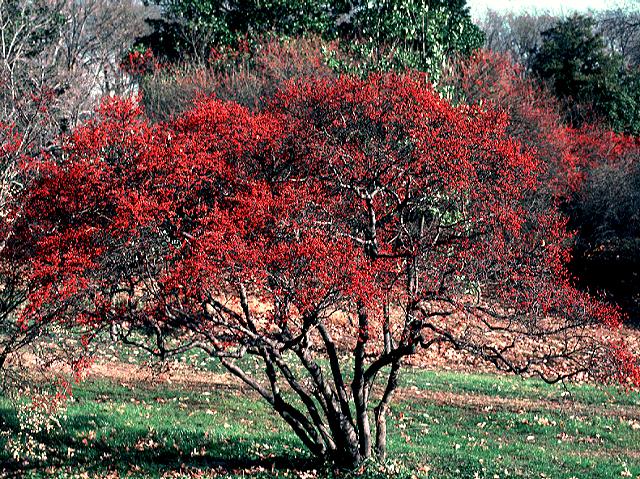
“Ilex serrata (sieboldii) (Japanese …” from www.treeshrubseeds.com and used with no modifications.
Deciduous shrubs contribute to the garden’s seasonal rhythm, with foliage that changes color and often falls away to reveal interesting branch patterns. They’re the plants that aren’t afraid to change it up and keep things interesting with their seasonal transformations. The Ilex serrata (Japanese Winterberry) captivates with its bushy form adorned with purple stems, while female trees bring a burst of red with their berries, adding vibrant color in the colder months.
|
Scientific Name |
Common Name |
USDA Hardiness Zones |
Features |
Size and Care |
|---|---|---|---|---|
|
Berberis thunbergii |
Japanese Barberry |
4-8 |
Thorny, dense, rounded shrub; good autumn color; resistant to deer browsing; drought and air pollution tolerant |
Height: 3-6 feet; Width: 4-7 feet; Prune two or three times a year to maintain size and shape; mid-spring, late summer, and autumn |
|
Disanthus cercidifolius |
Redbud Hazel |
5-8 |
Rounded shrub; heart-shaped leaves turning burgundy, orange, and crimson in autumn |
Height: 6-10 feet; Minimal pruning required; can be done to shape as desired |
|
Euonymus alatus |
Winged Euonymus |
4-8 |
Dense shrub; bright fall color; invasive in the US |
Height: 5-15 feet; Width: 5-15 feet; Generally minimal pruning is required unless controlling size or shape |
|
Euonymus oxyphyllus |
Korean Spindle Tree |
4-8 |
Slow-growing, upright tree; small white flowers in spring; gaudy seed heads in autumn |
Height: Up to 8 feet; Minimum pruning required, remove over-long branches when the plant is dormant |
|
Ilex serrata |
Japanese Winterberry |
5-9 |
Slow-growing, bushy with purple stems; female trees produce red berries |
Height: Up to 9 feet; No pruning needed except to reduce long spurs |
|
Lindera umbellata |
Kuromoji |
6-9 |
Elegant shrub; tolerates hard pruning once established |
Height: Up to 9 feet; Cut back main leaders to desired height late winter; remove old stems at base to avoid overcrowding |
|
Salix gracilistyla |
Rosegold Pussy Willow |
5-9 |
Waterside willow; fluffy gray catkins |
Height and Width not specified; Minimum pruning required |
For more information on ‘Japanese garden Deciduous shrubs’, explore our detailed guide here.
6) Flowering Trees: Cherry, Magnolia & Camellia
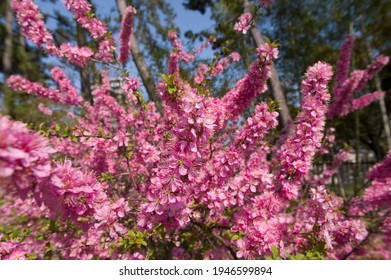
“Prunus Japonica Images, Stock …” from www.shutterstock.com and used with no modifications.
When you think about the blossoming trees in a Japanese garden, there’s one image that often comes to mind: the otherworldly elegance of Cherry Blossoms. Also known as Sakura, are more than just plants; they’re a cultural symbol, representing the ephemeral nature of life. Their bloom in the spring is a highly anticipated event, a sea of pink and white that encourages reflection and happiness. In addition to Cherry, other blooming trees like magnolia and camellia also play essential roles in Japanese gardens.
Cherry Varieties
|
Scientific Name |
Common Name |
USDA Hardiness Zones |
Features |
Size and Dimensions in Feet |
|---|---|---|---|---|
|
Prunus cerasoides var. rubra |
Kanbi-zakura |
Zones 5-8 |
Taiwan Cherry, Medium-sized tree |
20-30 feet tall |
|
Prunus incisa |
Fuji Cherry |
Zones 5-8 |
Fuji Cherry, Small tree |
15-20 feet tall |
|
Prunus jamasakura |
Japanese Hill Cherry |
Zones 6-9 |
Japanese Hill Cherry, Small to medium-sized tree |
20-30 feet tall |
|
Prunus japonica |
Oriental Bush Cherry |
Zones 6-9 |
Oriental Bush Cherry, Small tree |
15-25 feet tall |
|
Prunus mume |
Japanese Apricot |
Zones 6-9 |
Japanese Apricot, Small to medium-sized tree |
Varies, generally around 15-25 feet tall |
|
Prunus sargentii |
Sargent Cherry |
Zones 4-7 |
Sargent Cherry, Medium-sized tree |
Typically 25-35 feet tall |
|
Prunus speciosa |
Oshima Cherry |
Zones 5-8 |
Oshima Cherry, Medium-sized tree |
Around 20-30 feet tall |
|
Prunus x subhirtella |
Pendula |
Zones 5-8 |
Weeping Higan Cherry, Small tree with a weeping habit |
Generally 15-25 feet tall |
|
Prunus x yedoensis |
Yoshino Cherry |
Zones 5-8 |
Yoshino Cherry, Medium-sized tree |
Typically 25-40 feet tall |
Magnolia Varieties
|
Scientific Name |
Common Name |
USDA Hardiness Zones |
Features |
Size and Dimensions in Feet |
|---|---|---|---|---|
|
Magnolia figo |
Banana Shrub/Port-Wine Magnolia |
Zones 7-10 |
Evergreen shrub or small tree with fragrant flowers |
Typically 10-13 feet tall |
|
Magnolia kobus |
Kobushi Magnolia |
Zones 5-8 |
Deciduous tree with white, fragrant flowers in early spring |
25-50 feet tall |
|
Magnolia liliflora |
Lily Magnolia/Mulan Magnolia |
Zones 5-8 |
Deciduous shrub with large, showy purple flowers in late spring |
8-12 feet tall |
|
Magnolia obovata |
Japanese Big-Leaf Magnolia |
Zones 5-8 |
Large deciduous tree with huge leaves and white flowers |
Up to 80 feet tall |
|
Magnolia salicifolia |
Japanese Willow-Leaved Magnolia |
Zones 5-8 |
Japanese Willow-Leaved Magnolia, Deciduous tree |
Not specified |
Camellia Varieties
|
Scientific Name |
Common Name |
USDA Hardiness Zones |
Features |
Size and Dimensions in Feet |
|---|---|---|---|---|
|
Camellia japonica |
Yabu-tsubaki |
Zones 7-9 |
Evergreen shrub with glossy leaves and showy flowers |
6-12 feet tall, Spreads 5-10 feet |
|
Camellia sasanqua |
Sazanka |
Zones 7-9 |
Evergreen shrub with fragrant flowers that bloom in the fall |
4-10 feet tall, Spreads 5-7 feet |
For more detailed guidance on ‘Flowering Trees in Japanese Gardens’ , consider exploring our detailed guide here.
7) Flowering Shrubs: Japan’s Perennial Plants
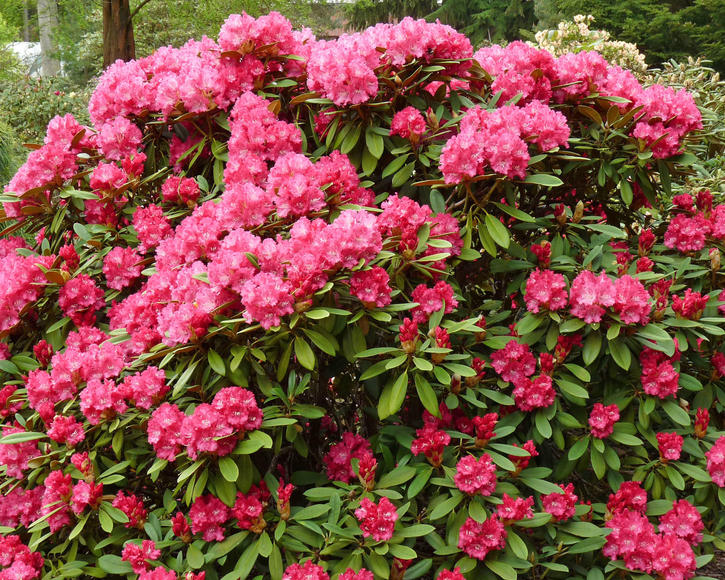
“Yakushimanum rhododendrons …” from www.mygarden.com and used with no modifications.
Flowering shrubs bring a rich complexity and intrigue to the garden. They are the perennials that keep on giving, returning each year like a well-known friend with a fresh tale to share. The Winter Daphne, with its intoxicating pale-pink blossoms and variegated foliage, and the Creeping Gardenia, with its richly perfumed white flowers, serve as blooming accents that harmonize with the garden’s design, reminding us to savor the ephemeral beauty of each moment.
|
Scientific and Common Name |
USDA Hardiness |
Features |
Size |
|---|---|---|---|
|
Corylopsis pauciflora (Buttercup Winter Hazel, Buttercup Witch Hazel) |
Zones 6-8 |
Deciduous shrub with racemes of pale primrose yellow flowers in late winter to early spring. Leaves turn yellow in fall. |
4 to 6 feet |
|
Corylopsis spicata (Tosa-mizuki, Spike Winter Hazel) |
Zones 5-8 |
Deciduous shrub with slender, pendant racemes of lemon-yellow flowers in March and April. |
4 to 8 feet height, 6 to 10 feet spread |
|
Daphne odora ‘Aureomarginata’ (Winter Daphne) |
Zone 7 and higher |
Evergreen shrub with fragrant, pale-pink flowers and glossy, yellow-edged foliage. |
Up to 5 feet |
|
Deutzia gracilis (Japanese Snow Flower, Hime-utsugi) |
Zones 5-8 |
Bushy, upright shrub with white, fragrant flowers in spring. Compact growth. |
Up to 3 feet |
|
Enkianthus perulatus (White Enkianthus, Dodan-tsutsuji) |
Zones 6-8 |
Deciduous shrub with heather-like flowers in early spring and red autumn foliage. |
1 to 2 feet |
|
Exochorda racemosa (Common Pearlbush, Rikyubai) |
Zones 5-8 |
Deciduous shrub with delicate, scented, white flowers in late April to May. |
Up to 15 feet |
|
Gardenia augusta ‘Radicans’ (Creeping Gardenia, Hime-kuchinashi) |
Zones 8-10 |
Dwarf gardenia with waxy, heavily scented white flowers in early summer. |
1 to 2 feet |
|
Hibiscus mutabilis (Confederate Rose Mallow, Fuyo) |
Zones 7-10 |
– |
Not specified |
|
Hypericum patulum (Kinshibai) |
Zones 6-7 |
Evergreen or semi-evergreen shrub with yellow cup-shaped flowers from August to October. |
Not specified |
|
Hydrangea macrophylla (Bigleaf Hydrangea, French Hydrangea, Lacecap Hydrangea, Hortensia) |
Zones 5-9 |
Includes lacecap and mophead forms. Flower color changes with soil pH. |
5 to 6 feet 7 inches |
|
Hydrangea paniculata (Panicle Hydrangea, Peegee Hydrangea) |
Zones 4-7 |
Fast-growing shrub with large, conical flower heads. |
Up to 9 feet 9 inches |
|
Hydrangea quercifolia (Oakleaf Hydrangea, Kashiwa-ajisai) |
Zones 6-9 |
White to cream-colored flowers in large panicles, oak-like leaves with good autumn color. |
Up to 6 feet |
|
Kerria japonica (Japanese Kerria, Japanese Rose) |
Zones 4-9 |
Bright yellow single or double flowers in spring. |
6 feet 6 inches x 8 feet |
|
Lespedeza bicolor (Japanese Bush Clover, Yama-hagi) |
Zones 5-8 |
Tiny purple-pink flowers at the end of summer and in autumn, weeping branches. |
5 to 6 feet 7 inches |
|
Lespedeza thunbergii (‘Albiflora’, ‘Versicolor’) |
Not specified |
‘Albiflora’ has white flowers, ‘Versicolor’ has white and rosy purple flowers. |
Not specified |
|
Loropetalum chinense (Chinese Fringe Flower, Tokiwa-mansaku) |
Zones 7-10 |
Evergreen shrub with scented white flowers, ‘Rubrum’ has pink or red flowers. |
Not specified |
|
Osmanthus fragrans f. aurantiacus (Fragrant Olive, Sweet Olive) |
Zones 8-10 |
Clusters of tiny orange blooms with an intense fruity scent in autumn. |
Up to 32 feet 6 inches |
|
Paeonia suffruticosa (Tree Peony, Moutan; Botan) |
Zones 4-8 |
Deciduous shrub with large, beautiful flowers and shallow roots. |
Up to 6 feet 7 inches |
|
Philadelphus satsumi (Satsumi Mock Orange) |
Zone 7 |
Deciduous, upright shrub with showy, scented flowers in summer. |
6 to 8 feet |
|
Rhaphiolepis umbellata (Yeddo Hawthorn, Indian Hawthorn; Sharinbai) |
Zones 8-10, warmer areas of zone 7 |
Evergreen shrub with small, oval leaves and clusters of white flowers in early summer. |
Up to 5 feet |
|
Rhododendron indicum (Satsuki Azalea) |
Zones 7-8 |
Small-leaved, dense, evergreen azaleas with bright pink flowers in late May. |
1 to 3 feet |
|
Rhododendron yakushimanum (Yakushima Rhododendron) |
Typically Zones 5-8 |
Evergreen rhododendrons with big leathery leaves, slow-growing. |
Up to 13 feet |
|
Rhododendron Tsutsuji Group (Azaleas) |
Not specified |
Covers all azaleas, both evergreen and deciduous, suitable for hard pruning. |
Not specified |
|
Deciduous Azaleas (R. quinquefolium, R. dilatatum, R. reticulatum, R. japonicum) |
Zones 6-8 |
Less vigorous growth, R. quinquefolium has delicate structure and white flowers. |
Not specified |
|
Serissa foetida (Snowrose, Tree-of-a-thousand-stars, Serissa) |
Zones 7-11 |
Semi-evergreen shrub with white flowers, leaves may drop in winter. |
2 to 4 feet |
|
Spiraea cantoniensis (Reeves’s Spiraea, Kodemari) |
Zones 7-9 |
Deciduous or semi-evergreen shrub that flowers in mid-spring, can be pruned into a sphere. |
3 feet 3 inches to 6 feet 7 inches |
|
Spiraea japonica (Japanese Spiraea) |
Zones 8-10 |
Clump-forming, deciduous shrub that flowers from May through July. |
4 to 6 feet |
|
Spiraea thunbergii (Baby’s Breath Spirea, Breath-of-Spring Spirea, Yuki-yanagi) |
Zones 4-8 |
Flowers in early spring with trailing branches. |
3 feet 3 inches to 5 feet |
|
Stachyurus praecox (Kibushi) |
Zones 7-8 |
Deciduous shrub with yellow flowers in March and good autumn leaf color. |
3 to 5 feet |
|
Viburnum furcatum (Forked Viburnum, Scarlet-leaved Viburnum, Mushikari) |
Zones 5-9 |
Deciduous shrub with scented white flowers in May and good autumn color. |
Up to 11 feet 2 inches |
|
Viburnum japonicum (Hakusanboku) |
Zones 7-9 |
Evergreen shrub with small, fragrant white flowers in early summer. |
Up to 6 feet |
|
Viburnum phlebotrichum (Otoko-yozome) |
Zone 5 |
Small white flowers, leaves turn crimson in autumn. |
Up to 8 feet |
|
Viburnum plicatum (Japanese Snowball, Odemari) |
Zones 5-8 |
Deciduous shrub with large, spherical white flowerheads. |
Up to 3 meters (9 feet 9 inches) |
For a more comprehensive list of ‘Japanese garden blooming shrubs’, check out here.
8) Creating Harmony with Foliage and Flowers
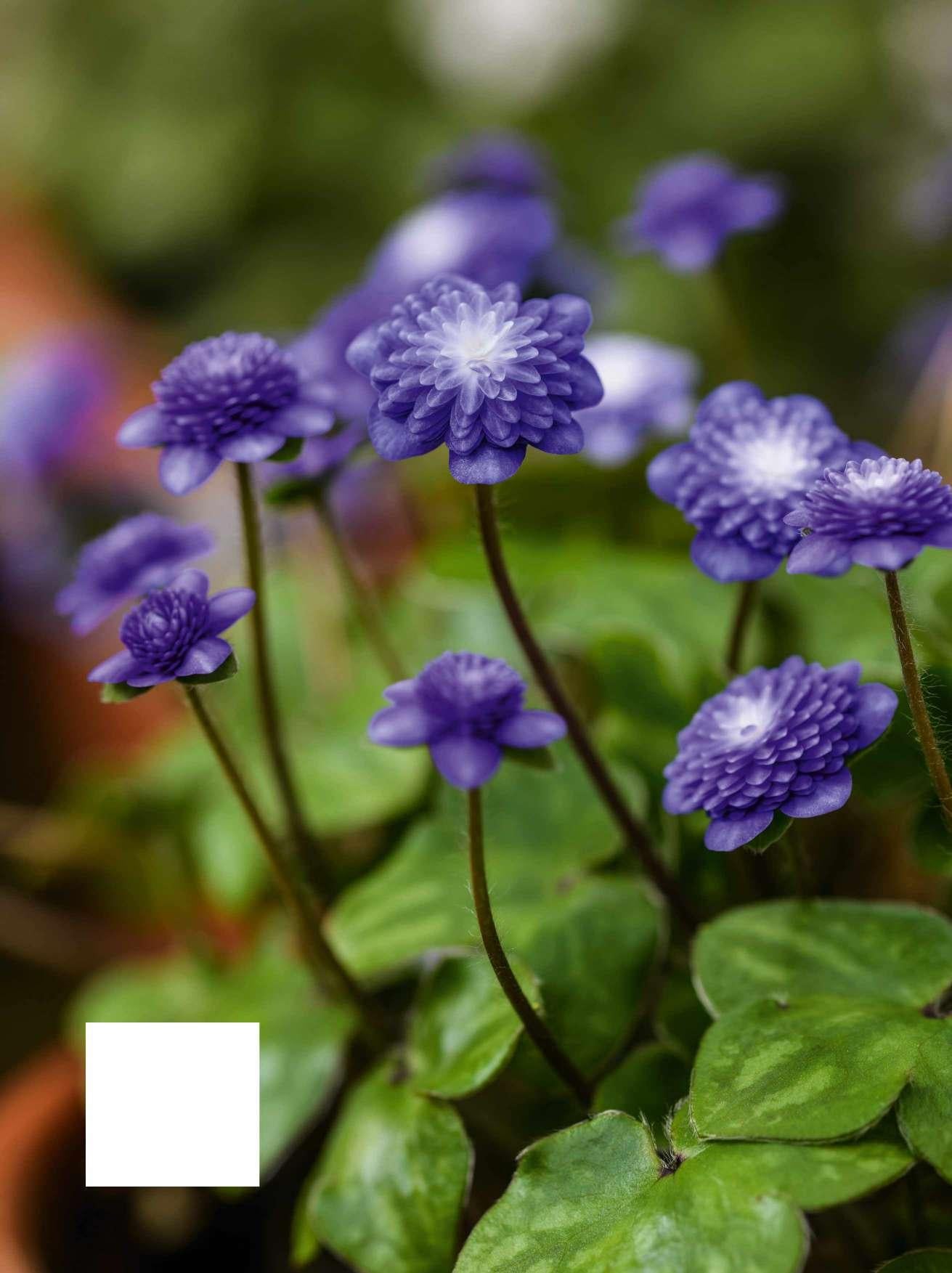
Plant profile: Hepatica – Issuu” from issuu.com and used with no modifications.
The beauty of a Japanese garden lies in the harmony and balance of its components. When you’re mixing foliage and flowers, imagine you’re composing a song. Each plant has its part to play, and together, they produce a visual feast. The Ha-ran, with its resilient, dark, glossy leaves, introduces a lush, verdant texture, while the Tsuwabuki, an evergreen perennial, adds a bright, reflective quality to shaded areas, enhancing the garden’s overall harmony and balance.
And don’t be afraid to get creative. Sometimes, the most beautiful combinations come from trying something new. Just remember, the key to every Japanese garden is simplicity and natural beauty.
8.1) FOLIAGE
|
Scientific and Common Name |
Description |
Size |
USDA Hardiness Zones |
Growing Conditions and Maintenance |
|---|---|---|---|---|
|
Aspidistra elatior (Ha-ran) |
Resilient plant with dark, glossy leaves that can add a lush, verdant texture to tea gardens. |
24 – 36 inches tall, 12 – 30 inches wide |
8 through 10 |
Shade, well-drained soil, regular watering during dry periods. |
|
Farfugium japonicum (Tsuwabuki) |
Evergreen perennial with glossy leaves that can bring a bright, reflective quality to shaded garden areas. |
30 cm (1 ft) in height |
7 through 10 |
Moist conditions, partial or complete shade, well-draining but consistently moist soil. |
|
Hosta spp. (Plantain Lily; Giboshi) |
Versatile perennials with a wide variety of leaf shapes, sizes, and colors, producing tall spikes of flowers in summer. |
Varies by species, from small to large |
Varies by species, from 3 through 9 to 3 through 8 |
Partial to full shade, well-drained, moist soil, regular watering, mulching in spring. |
|
Pachysandra terminalis (Japanese Spurge; Fukkiso) |
Evergreen ground cover that forms dense mats of glossy leaves in whorls. |
25 x 60 cm (10 in x 2 ft) |
5 through 8 |
Partial to deep shade, slightly acidic to neutral soil, annual acid fertilizer if soil is neutral, pinch out tips for denser growth. |
|
Rohdea japonica (Japanese Sacred Lily; Omoto) |
Evergreen perennial with leathery leaves and greenish-yellow flower-heads followed by red or white berries. |
Foliage up to 30 cm (1 ft) long |
6 through 10 |
Moist, acidic soil in shade, suitable for understory planting or ground cover. |
8.2) FLOWERS
|
Scientific and Common Name |
Description |
Size |
USDA Hardiness Zones |
Growing Conditions and Maintenance |
|---|---|---|---|---|
|
Arisaema thunbergii subsp. urashima (Urashima-so) |
Herbaceous perennial with a unique jack-in-the-pulpit-like spathe and poisonous roots. |
8 to 10 cm (3 to 4 in) |
5 through 9 |
Partial to full shade, humus-rich, moist, well-drained soil. |
|
Aster tataricus (Shion) |
Tall perennial with pale, delicate lavender flowers blooming in autumn. |
Up to 2 m (6 ft 7 in) |
3 through 7 |
Moist soil, full sun, not suitable for shaded conditions. |
|
Astilbe (Chidake-sashi) |
Dwarf hybrid ‘Sprite’ with dark foliage and pale pink flower spikes in summer. |
About 30 cm (1 ft) tall |
4 through 8 |
Rich, moist soil in partial shade, consistent moisture. |
|
Begonia grandis subsp. evansiana (Shukaido) |
Perennial with fleshy stalks, red flush around the nodes, and pale red single flowers. |
About 50 cm (1 ft 8 in) |
6 through 9 |
Protection from winter cold, moist, well-drained soil, partial shade. |
|
Bletilla striata (Shi-ran) |
Deciduous terrestrial orchid with lance-shaped leaves and bright pink flowers. |
Not very tall |
5 through 9 |
Moist, rich soil, partial shade, mulch in autumn or lift and store tubers. |
|
Calanthe discolor (Ground Orchid; Ebine) |
Woodland orchid from Japan with maroon and white flowers on a tall stem. |
Noticeable height |
6 through 9 |
Partial shade, moist, humus-rich, well-drained, acidic to neutral soil, dry in winter. |
|
Chelonopsis moschata (Jako-so) |
Slow-spreading perennial with tiny, deep mauve penstemon-like flowers. |
Up to 60 cm (24 in) |
5 through 9 |
Damp conditions, partial shade. |
|
Chloranthus japonicus (Hitori-shizuka) |
Dainty perennial with a single spike of white, scented, bottlebrush-like flowers. |
Up to 60 cm (24 in) tall, 90 cm (36 in) spread |
6 through 9 |
Partial shade, moist, well-drained soil. |
|
Chloranthus serratus (Futari-shizuka) |
Produces two spikes of scented, white, bottlebrush-like flowers. |
Similar to Chloranthus japonicus |
6 through 9 |
Moist, well-drained soil in partial shade. |
|
Clintonia udensis (Tsubame-omoto) |
Herbaceous, clump-forming perennial with bell-shaped white flowers in racemes. |
30 x 20 cm (1 ft x 8 in) |
5 through 8 |
Fertile, moist, neutral to acidic soil in partial or full shade. |
|
Scientific and Common Name |
Description |
Size |
USDA Hardiness Zones |
Growing Conditions and Maintenance |
|---|---|---|---|---|
|
Dicentra peregrina (Bleeding-heart; Koma-gusa) |
Japanese herbaceous perennial with distinctive heart-shaped flowers. ‘King of Hearts’ cultivar has red flowers. |
Not specified |
5 through 9 |
Humus-rich, moist, slightly acidic soils in partial shade. Regular dead-heading and division every six to ten years. |
|
Disporum smilacinum (Chigo-yuri) |
Perennial with one or two pendent flowers on each stem in spring. |
20 to 25 cm (8 to 10 in) high |
4 through 8 |
Partial shade and consistently moist soil. |
|
Eupatorium fortunei (Fuji-bakama) |
Known for its pale lavender umbels that bloom in autumn. |
1 m (3 ft 3 in) |
4 through 9 |
Moist soil, full sun to partial shade. |
|
Filipendula purpurea (Kyoganoko) |
Forms clumps of toothed leaves and feathery crimson flowers in summer. |
1.2 m x 60 cm (4 ft x 2 ft) |
3 through 8 |
Full sun to partial shade, moist soil, suitable near water. |
|
Gentiana makinoi (Oyama-rindo) |
Herbaceous perennial with pale blue flowers in late summer. |
Not specified |
5 through 9 |
Acidic soil, full sun to partial shade, ideal for rock gardens or alpine settings. |
|
Gymnaster savatieri (Gymnaster/Aster savatieri; Miyako-wasure) |
Produces pale blue or white aster-like flowers in late season. |
30 to 60 cm (1 to 2 ft) high, 60 to 75 cm (2 to 2.5 ft) spread |
5 through 7 |
Full sun or partial shade, adaptable to soil conditions. |
|
Heloniopsis orientalis (Shojo-bakama) |
Evergreen perennial with strap-like leaves and star-shaped flowers. |
Not specified |
5 through 8 |
Shade, moist, well-drained soil. |
|
Hemerocallis spp. (Daylilies) |
Variety of daylilies, including tawny daylily (H. fulva) with double flowers. |
Not specified |
4 through 9 |
Moist but not wet soil in full sun, some species may be invasive. |
|
Hepatica nobilis var. japonica (Yuki-wari-so) |
Semi-evergreen perennial with star-shaped purple-blue flowers in early spring. |
Not specified |
5 through 8 |
Neutral, heavy soil in partial shade, good for rock gardens, resents transplanting. |
|
Iris japonica (Shaga) |
Frost hardy with flowers blooming in spring to early summer. |
Not specified |
7 through 9 |
Well-shaded, moist soil. |
|
Scientific and Common Name |
Description |
Size |
USDA Hardiness Zones |
Growing Conditions and Maintenance |
|---|---|---|---|---|
|
Iris sanguinea (Ayame) |
Beardless iris with grass-like leaves and violet flowers. |
Up to 90 cm (3 ft) |
4 through 9 |
Moist but not wet soil in full sun. |
|
Liriope muscari (Yabu-ran) |
Evergreen perennial with pale lavender flower spikes in autumn. |
Not specified |
5 through 10 |
Well-drained soil in sun, partial shade, or shade. |
|
Millettia japonica (False Dwarf Wisteria; Hime-fuji) |
Legume with narrow wisteria-like leaves and violet flowers in summer. |
60 to 90 cm (2 to 3 ft) |
8 |
Rich, moist soil, can be grown in a container. |
|
Physalis alkekengi (Chinese Lantern; Hozuki) |
Known for bright orange, papery, lantern-shaped seed pods in autumn. |
Not specified |
3 through 9 |
Full sun, can spread aggressively by rhizomes. |
|
Platycodon grandiflorus (Balloon Flower; Kikyo) |
Known for purple, white, or pink flowers that bloom in early autumn or summer. |
Not specified |
3 through 8 |
Sunny, rich soil. |
|
Polygonatum falcatum (Fragrant Solomon’s Seal; Naruko-yuri) |
Produces greenish-white delicate pendulous flowers along the stem. |
Not specified |
4 through 8 |
Well-drained soil and partial shade. |
|
Sedum alboroseum (Autumn Stonecrop; Benkei-so) |
‘Mediovariegatum’ has variegated leaves and large, white flower heads in late summer. |
Up to 50 cm (20 in) high, 30 to 45 cm (12 to 18 in) spread |
4 through 9 |
Full sun to partial shade, well-drained soil. |
|
Sedum kamtschaticum (Russian Stonecrop; Kirin-so) |
Creeping sedum with yellow flowers in late summer, drought-tolerant. |
About 15 cm (6 in) |
4 through 9 |
Good drainage and full sun. |
|
Saxifraga fortunei var. incisolobata (Daimonji-so) |
Mound-forming herbaceous perennial with flowers from August to November. |
Up to 25 cm (10 in) high, 20 to 50 cm (8 to 20 in) spread |
6 through 9 |
Partial to full shade, regular watering. |
|
Stauntonia hexaphylla (Mube) |
Evergreen climber with glossy leaves and lightly scented bell-like flowers. |
Can grow to 9 m (30 ft) or more |
8 through 11 |
Tolerant of very acid and alkaline soils, frost hardy. |
|
Tricyrtis hirta (Toad Lily; Hototogisu) |
Clump-forming perennial with spotted purple flowers in summer to early autumn. |
60 to 100 cm (2 to 3 ft 3 in) high |
4 through 8 |
Moist, slightly acidic, well-shaded conditi |
For more information on ‘Foliage & Flowers in Japanese gardens’, explore our detailed guide here.
9) Bamboo: The Elegant Survivor
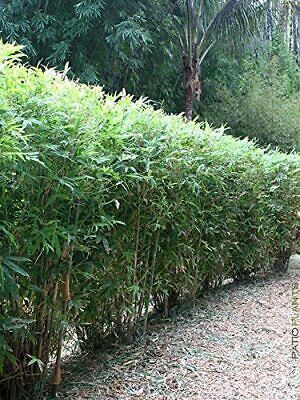
“Red Temple Bamboo / Narihira Bamboo …” from www.ebay.com and used with no modifications.
In the Japanese garden, bamboo is a symbol of both flexibility and strength. It bends with the wind, but it doesn’t break, showing us how to be resilient. With its tall, graceful stems and leaves that rustle in the wind, bamboo adds both motion and soothing sound to the garden.
There are a variety of bamboo species available, each with its own unique features. Some are tall and majestic, while others are shorter and more demure. Some grow rapidly and spread out, while others remain in their designated area. Choose a species that matches your space and style, and make sure to control its growth to preserve your desired design.
|
Scientific and Common Name |
Description |
Size (Height) |
USDA Hardiness Zones |
Care and Maintenance Tips |
|---|---|---|---|---|
|
Bambusa multiplex (Hedge Bamboo) |
Clumping bamboo ideal for hedges and privacy screens. |
3 to 5 m (9 ft 9 in to 16 ft 3 in) |
8 and above |
Prefers full sun to partial shade. Regular watering. Prune to maintain shape. Use a root barrier. |
|
Chimonobambusa marmorea (Kan-Chiku) |
Low-growing bamboo with solid stems and red, mottled culms. |
Up to 3 m (9 ft 9 in) |
8 through 10 |
Prefers shade and rich soil. Can be invasive; use a root barrier. |
|
Hibanobambusa tranquillans (Inyo-Chiku) |
Hardy hybrid with large leaves and smooth canes. |
3 to 5 m (9 ft 9 in to 16 ft 3 in) |
7 through 9 |
Prefers acidic soil. Can be invasive; use a root barrier. |
|
Phyllostachys bambusoides (Ma-Dake) |
Tall bamboo used for groves and crafts. |
10 to 20 m (32 ft 6 in to 65 ft) |
7 through 10 |
Prefers full sun and rich soil. Difficult to transplant. Prune in spring. |
|
Phyllostachys edulis (Moso-Dake) |
The thickest bamboo, used for groves and edible shoots. |
15 to 20 m (49 to 65 ft) |
8 through 10 |
Prune in spring to desired height. Use a root barrier. |
|
Phyllostachys nigra (Kuro-Chiku) |
Canes turn black over time. Suitable for small gardens. |
2 to 3 m (6 ft 7 in to 9 ft 9 in) |
7 and above |
Prefers shade. Can be invasive; use a root barrier. |
|
Phyllostachys pubescens var. heterocycla (Kikko-Chiku) |
Mutation of P. edulis with zig-zag joints and bulging culms. |
N/A |
7 and above |
Rare ornamental bamboo. Use a root barrier. |
|
Phyllostachys sulphurea (Ogon-Ko-Chiku) |
Green canes turn bright yellow streaked with green. |
Up to 8 m (26 ft) |
7 and above |
Can be invasive; use a root barrier. |
|
Pleioblastus simonii (Me-Dake) |
Good hedging bamboo but highly invasive. |
Up to 6 m (10 ft) |
7 through 10 |
Use a root barrier or cultivate in a container. |
|
Semiarundinaria fastuosa (Narihira Bamboo) |
Tall, upright bamboo with green culms striped burgundy-brown. |
Up to 7 m (25 ft) |
7 through 10 |
Prune in spring. Use a root barrier. |
|
Semiarundinaria kagamiana (Rikuchu-Dake) |
Bushy bamboo that tolerates both sun and shade. |
3 to 5 m (9 ft 9 in to 16 ft 3 in) |
6 through 9 |
Can be very invasive; use a root barrier. |
|
Semiarundinaria yashadake “Kimmei” |
Yellow culms tinted pink and green, turning dusky red in sunlight. |
N/A |
7 through 10 |
Can be very invasive; use a root barrier. |
|
Sinobambusa tootsik (To-Chiku) |
Pruned for rounded leaf growth. |
3 to 8 m (9 ft 9 in to 26 ft) |
9 and 10 |
Hardy to -10°C/14°F. Can be very invasive; use a root barrier. |
|
Tetragonocalamus quadrangularis (Shiho-Chiku) |
Canes flattened on all four sides. |
5 to 6 m (16 ft 3 in to 19 ft 6 in) |
8 through 11 |
Prefers shade and rich soil. Difficult to transplant. Use a root barrier. |
For a more information on ‘Japanese garden Bamboo types’, check out here.
10) Grass in Japanese Gardens
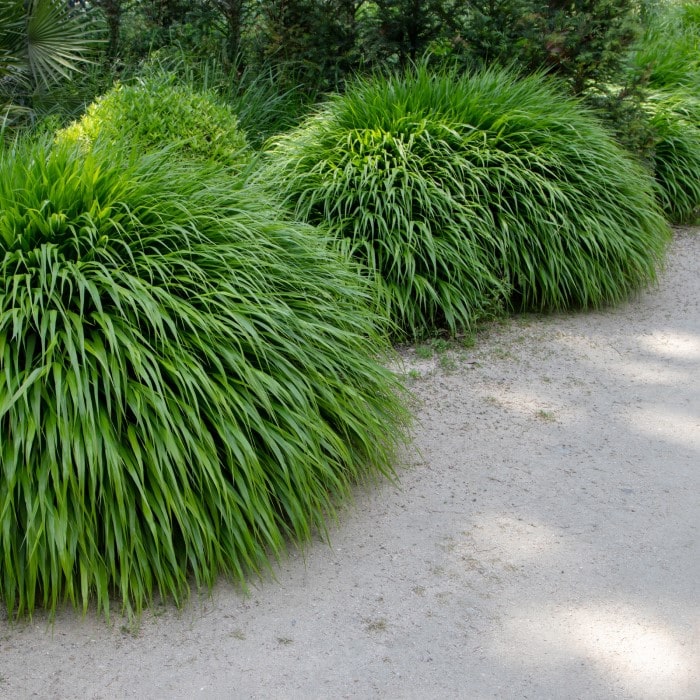
“Hakone Grass | Hakonechloa macra …” from almanacplanting.com and used with no modifications.
Grasses are simple, and that’s what makes them so powerful. They don’t demand attention, they simply enhance the other elements, swaying softly and giving the garden a sense of calm and stability.
Grasses are available in a variety of heights and colors. They can also provide a softer look to the edges of paths and ponds with their elegant shapes. Japanese gardens grasses range from the flowing mounds of Hakone grass to the upright forms of Japanese sedge.
|
Scientific and Common Name |
Description |
Size (Height x Width) |
USDA Hardiness Zones |
Care Tips |
|---|---|---|---|---|
|
Carex hachijoensis (Evergold Sedge) |
An evergreen sedge with creamy yellow and green variegated foliage, tufted and adaptable to various light conditions |
30 cm x 35 cm (1′ x 1’2″) |
Zones 5-10 |
Light trimming in late winter/early spring, prefers moist well-drained soil, pest and disease resistant |
|
Hakonechloa macra (Aureola) |
A variegated Japanese forest grass with bright gold leaves and green stripes, red-tinted in autumn |
36 cm x 40 cm (1’2½” x 1’4″) |
Zones 5-9 |
Consistent moisture, slow grower, prefers partial shade, pest and disease-free, deer resistant |
|
Imperata cylindrica (Japanese blood grass) |
A grass with distinctive blood-red leaf tips, more controlled and garden-friendly than the species |
Up to 50 cm long leaves |
Zones 5-9 |
Minimal maintenance, prefers full sun to partial shade, moist well-drained soil |
|
Miscanthus sinensis (Chinese Silvergrass) |
Culturally significant in Japan, but recognized as an invasive species |
Not specified |
Not specified |
Consider non-invasive alternatives due to its invasive nature |
|
Muhlenbergia capillaris (Pink Muhlygrass) |
Known for its superb pink flower plumes in autumn, thrives in sandy or rocky well-drained soils, full sun |
Up to 90 cm (3′) |
Zones 5-9 |
Minimal maintenance, prefers full sun |
|
Schizachyrium scoparium (Little Bluestem) |
A medium-sized grass that adds vertical interest and is disease-free, useful for erosion control |
Up to 1.2 meters (4′) |
Zones 3-9 |
Cut back old foliage in late winter to early spring |
|
Sorghastrum nutans (Indian Grass) |
Tall, clump-forming, adaptable to various soil types, drought-tolerant |
90 to 150 cm (3 to 5′) |
Zones 4-9 |
Cut back old foliage in late winter to early spring |
|
Sporobolus heterolepis (Prairie Dropseed) |
Scented flowers late summer to early autumn, native to North America, fine-textured foliage |
60 to 90 cm (2 to 3′) |
Zones 3-9 |
Drought-tolerant once established, minimal maintenance, prefers well-drained soils |
For a more comprehensive list of ‘Japanese garden Grass’, check out here.
11) Moss: An Invitation to Tranquility

“Moss in the Japanese garden | Real …” from realjapanesegardens.wordpress.com and used with no modifications.
Moss flourishes in the cool, damp spaces beneath trees and rocks. It creates a living carpet that beckons you to pause and stay awhile. Moss adds an element of antiquity and stability to the garden, giving the impression of a place untouched by time.
Moss is easy to take care of: just keep it wet and clean. It’s a plant that doesn’t need much, but gives a lot—a rich green that can make even the tiniest garden feel like a timeless forest.
|
Type of Moss |
Features |
Care Tips |
|---|---|---|
|
Polytrichum formosum (O-sugi-goke) |
Lush, dense growth resembling a miniature forest floor. Thrives in damp, shaded areas. Tall, upright growth adds texture and depth. |
Prefers damp, shaded areas. Maintain moisture for optimal growth. |
|
Racomitrium canescens (Suna-goke) |
Silver-green color with a wiry texture. Can withstand more sunlight and drier conditions. Perfect for rock gardens. |
Can tolerate more sunlight and drier conditions. Ideal for rock gardens or challenging areas. |
|
Thuidium tamariscinum (O-shinobu-goke) |
Fern-like structure, delicate and lacey. Prefers moist, well-drained soil and a bit of shade. |
Keep soil moist and well-drained. Provide some shade to mimic its natural habitat. |
|
Campylopus japonicus (Yamato-fude-goke) |
Spiky appearance with upright growth and bright green tufts. Drought-tolerant and suited for rock gardens. |
Prefers moisture but is drought-tolerant. Suitable for rock gardens and as an accent in sandy or gravel paths. |
|
Leucobryum neilgherrense (Hosoba-shiraga-goke/Yama-goke) |
Cushiony, pale green clumps that brighten up shady spots. Adds a whimsical touch to the garden. |
Thrives in acidic soil. Once established, requires minimal maintenance. Ideal for shady areas. |
|
Dicranum scoparium (Kamoji-goke) |
Robust, upright growth resembling tiny broom heads. Hardy and versatile, can grow on both soil and wood. |
Adaptable to various conditions. Can be used to cover ground or drape over logs and stones for structure. |
For more detailed guidance on ‘Japanese Garden Moss’ , consider exploring our detailed guide here.
12) The Unsung Heroes: Ground Covers
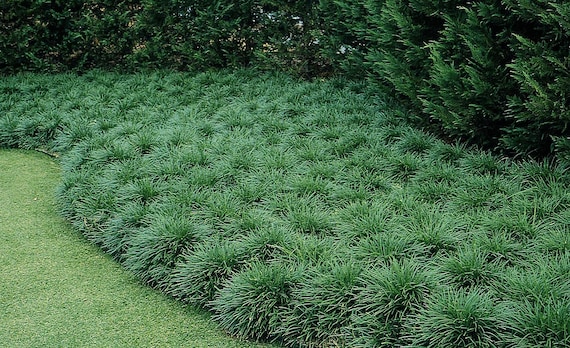
“Green Mondo Grass/ Ophiopogon Japonicus …” from www.etsy.com and used with no modifications.
Ground covers might not be the first plants that come to mind when you think of a Japanese garden, but they play a crucial role in tying everything together. They are like a blanket thrown over the earth, their varied textures and shades of green covering the bare soil.
When you’re planting ground cover plants, consider how they will spread and interact with other plants. They should be supportive, not competitive. When chosen and placed carefully, ground cover plants can help to unify your garden, creating a peaceful, harmonious scene.
|
Name of Plant |
USDA Hardiness Zones |
Requirements for Light |
Soil Preferences |
Water Needs |
Special Characteristics |
|---|---|---|---|---|---|
|
Epimedium grandiflorum var. thunbergianum (Bishop’s Hat) |
5-9 |
Partial to full shade |
Humus-rich, well-drained |
Consistently moist |
Colorful spring blooms |
|
Ophiopogon japonicus (Mondo Grass) |
6-10 |
Partial shade |
Well-drained |
Regular watering |
Dense mat, can handle foot traffic |
|
Reineckea carnea (Kichijo-so) |
7-10 |
Partial to full shade |
Moist, well-drained |
Drought-tolerant once established |
Evergreen, late-year blooms |
|
Saxifraga stolonifera (Yuki-no-shita) |
6-9 |
Partial shade, cool moist conditions |
Moist, well-drained |
Extra water during dry spells |
Alpine charm, white blooms |
|
Syneilesis palmata (Shredded Umbrella Plant) |
5-7 |
Partial shade |
Rich, well-draining |
Moist but not waterlogged |
Unique dissected leaves |
For more information on ‘Japanese Garden Ground Cover Plants’, explore our detailed guide here.
13) Ferns: The Epitome of Elegance
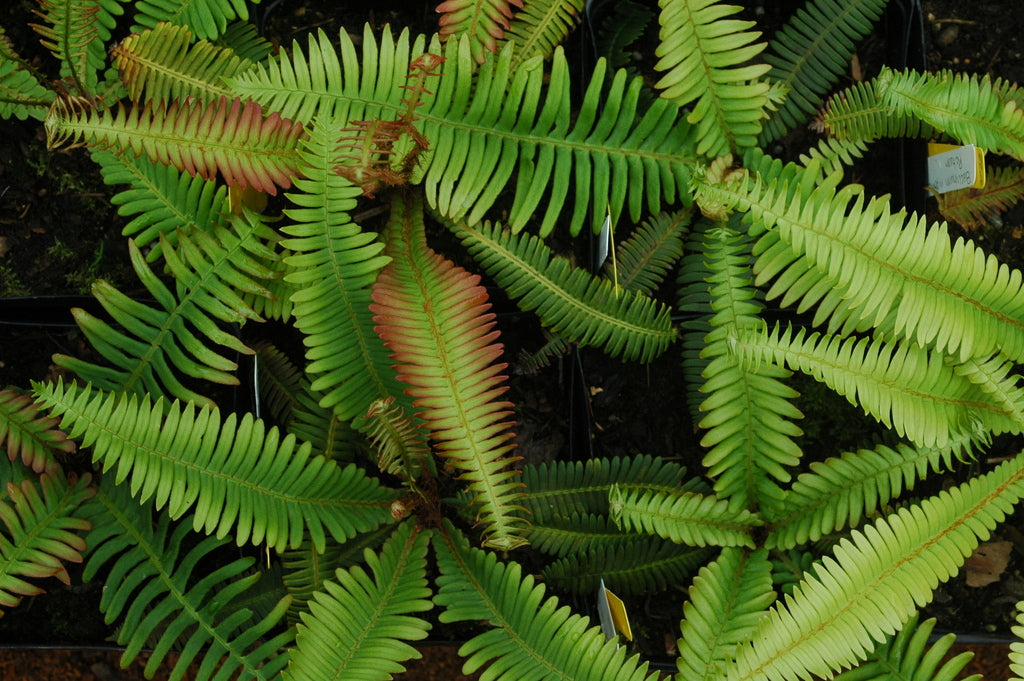
“Blechnum nipponicum (Japanese Deer Fern …” from www.keepingitgreennursery.com and used with no modifications.
With their delicate fronds swaying like a dancer, ferns are the epitome of elegance in a Japanese garden. They thrive in the dappled light under trees, adding a soft texture and a deep, verdant green. Ferns are easy to care for: they thrive in moist, organic-rich soil. Mulch around them to keep their roots cool and moist, and they will provide you with their timeless beauty.
|
Scientific and Common Name |
Description |
Maintenance and Care Tips |
|---|---|---|
|
Adiantum aleuticum (Aleutian Maidenhair Fern) |
A deciduous or semi-evergreen fern with graceful, bright green fronds that open like the fingers of a hand atop upright, shiny, purple-black wiry stems |
Plant in part-shade to full-shade locations, ensure well-draining soil rich in organic matter, and water regularly to maintain evenly moist soil |
|
Blechnum nipponicum (Japanese Deer Fern) |
A hardy fern with glossy, dark green fronds that are evergreen in many climates, providing structure and color even in winter |
Can withstand a range of climates (USDA zones 5-9), prefers acidic to neutral well-drained soil, and benefits from mulching to retain soil moisture |
|
Cyrtomium macrophyllum (Large Leaf Holly Fern) |
A fern with bold, leathery fronds that add texture and a touch of the exotic to garden spaces |
Prefers partial to full shade, amend soil with compost for a rich growing medium, and water deeply but infrequently |
|
Davallia mariesii (Hare’s Foot Fern) |
Known for its furry rhizomes that creep over the soil or along pots, adding whimsy to shaded patios and balconies |
Requires excellent drainage, use a potting mix rich in organic matter, and ensure the site doesn’t collect standing water |
|
Dryopteris erythrosora (Japanese Red Shield Fern) |
Features metallic coppery-red new fronds that mature to deep green, offering year-round interest with changing colors |
Regular watering to maintain consistent soil moisture, use organic mulch to retain moisture and enrich the soil, and plant in a location with dappled sunlight or light shade |
|
Equisetum hyemale (Horsetail) |
A reed-like plant with striking vertical lines and a prehistoric appearance, suitable for water gardens or pond edges |
Thrives in wet, boggy conditions, prefers full sun to partial shade, and consider planting in containers to prevent aggressive spreading |
|
Matteuccia struthiopteris (Ostrich Fern) |
A clump-forming fern with feathery fronds resembling ostrich plumes, ideal for filling in large, shady areas |
Give room to grow, prefers moist, rich soil and a bit of shade, and can act as a groundcover or provide a contrasting backdrop |
|
Polystichum polyblepharum (Japanese Tassel Fern) |
An evergreen fern with glossy, dark green fronds that emerge in a tassel-like form before unfurling |
Leverages evergreen beauty for year-round interest, prefers shade but can handle dappled sunlight, and maintain moist but well-drained soil |
|
Selaginella tamariscina (Peacock Fern) |
Not a true fern, it has iridescent, peacock-blue foliage and forms dense mats as a groundcover |
Create a dynamic contrast with softer fern textures, use as a striking groundcover in shaded areas, and keep in mind its preference for higher humidi |
For more information on ‘Types of Ferns Used in Japanese Gardens’, explore our detailed guide here.
Wrapping Up
So, there you have it. The plants we select for our Japanese gardens are more than just pretty to look at. From the towering conifers to the lowly moss, each has a role to play in creating a space that encourages quiet reflection and serenity. When you choose and care for these plants, keep in mind that you’re not just gardening. You’re creating an experience, a journey through a natural landscape condensed into its purest form of beauty.
Take these suggestions, let your imagination run wild, and see your garden transform into a Zen retreat that tells the ancient tales of the natural world. May your garden bring you peace and happiness throughout the year.

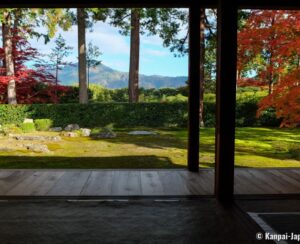
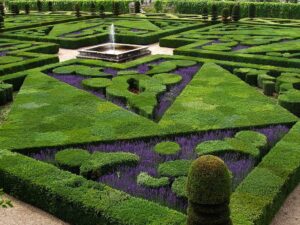
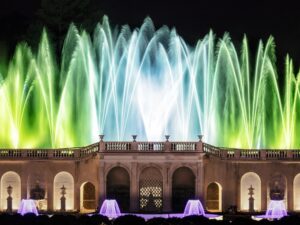
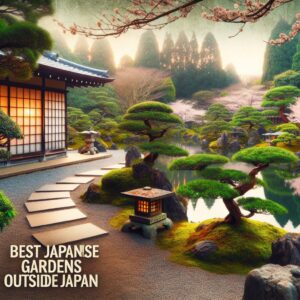
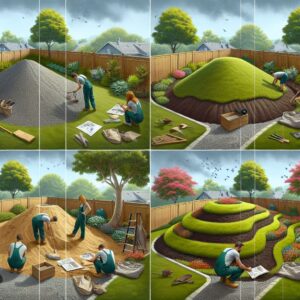
Leave a Reply